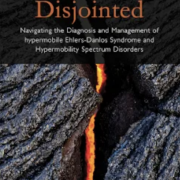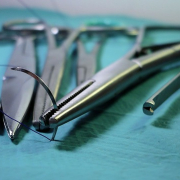Small Fiber Neuropathy is a Common Feature in Hypermobile EDS, Research Finds
New research by a German group of scientists published in the European Journal of Neurology seeks to understand if there is an underlying common cause among hypermobile EDS (hEDS), small fiber neuropathy (SFN), and postural orthostatic tachycardia syndrome (POTS). Their research sheds light on a possible common mechanism behind those three conditions.
SFN, POTS & hEDS
It has been proven many times that these three conditions – hEDS, POTS and SFN – frequently occur together. However, what research so far failed to find out was why. “Finding the underlying mechanism is so difficult because there are so many different symptoms, phenotypes and potential causes of these disorders. Connective tissue, the autonomic nervous system and small fibers are everywhere in the body. So I believe there is not the one pathomechanism, which makes it even more challenging,” Dr. Andrea Maier says. Maier is the leading neurologist at the University of Aachen’s department for the diagnosis and treatment of varying forms of dysautonomia and is part of the German group of researchers studying the connection between hEDS, POTS and SFN.
There are a number of different types of neuropathy–the medical name for the symptoms, such as weakness, numbness, and pain that come from nerve damage. One of the most common is peripheral neuropathy–when peripheral nerves in the arms, legs, feet, and hands are damaged due to an injury or illness. Diabetes is the leading cause of a type of peripheral neuropathy that occurs in the feet, but the condition can really be caused by any kind of trauma, including injuries, infections, toxins, surgery and more.
Another type of neuropathy is called autonomic neuropathy and results from damage to the autonomic nervous system, the part of the nervous system responsible for all of the body functions we can’t control ourselves, for example, heart rate, blood pressure, breathing, sweating, and much more. Orthostatic intolerance and its relative POTS are common in the hEDS population.
Additionally, small fiber neuropathy is yet another neuropathy often reported in people with hEDS. SFN concerns the tiny nerves that are in the skin’s tissue that help us distinguish sensitive differences in temperature, texture, and other sensory input. In a patient with SFN, these nerves are less dense than they would be in a patient without SNF. Along with numbness and decreased sensitivity, SFN can cause increased pain that may be outsized in comparison to the stimuli, a burning or cooling sensation in the skin, and the prickling sensation of “pins and needles.”
Past Studies
Many research studies have suggested a connection between hEDS and POTS; others have suggested a possible link between hEDS and neuropathies, specifically SFN, and others have reported neuropathy as a possible cause of dysautonomia.
For instance, even back in 2002, Gazit et al. published a paper mentioning the connection between “Joint Hypermobility Syndrome” (this condition does not exist in the NY classification and is now referred to as Hypermobility Spectrum Disorders) and POTS. They suggested the reason for it was peripheral neuropathy. Additionally, a study by De Wandele et al. described that dysautonomia occurs much more often in the EDS population, and neuropathy might be a contributing factor. And moreover, a small study by Cazzato et al. in 2016 revealed that SFN is, indeed, a common feature in (h)EDS (a few people with vEDS and cEDS were involved as well, but the majority was hEDS).
Over the last years, it became obvious that clearly, hEDS, POTS and SFN are connected, but really, this only led to more questions. “I started researching these conditions because I wanted to find answers to those open questions for my patients,” Maier states. And her group’s research adds a few more pieces and paves the way to finally finishing that puzzle.
New Research Results
In the study, 31 people with hEDS and 31 people without were compared using four methods: skin biopsies, quantitative sensory testing, tilt-table testing, and three questionnaires (painDetect, Small Fiber Neuropathy Screening List, and COMPASS-31). “Our research was unique in that regard because it investigated skin biopsies from proximal and distal positions,” Maier says. The group took two biopsies from each patient: one from the thigh and one from the lower leg. Usually, only one tissue sample is used to diagnose SFN.
The results of this preliminary study showed that patients with hEDS were more likely to have reduced small nerve fibers in the skin consistent with SFN than the control group. Patients with hEDS were also more likely to meet the criteria for POTS, have higher heart rates, and be more sensitive to heat and touch. The authors indicate that this research shows small fiber neuropathy is a common presentation in patients with hEDS and is an important addition to understanding the autonomic and neuropathic dysfunctions in hEDS. In short: small fiber neuropathy seems to be the cause of some of the POTS cases in the hEDS population. More long-term studies are needed to put these pieces of information together in a clear way that explains why patients with hEDS are more likely to experience these problems. “The better we understand the neuropathic pain in hEDS, the more patients may be diagnosed and believed. And this hopefully leads to better treatment options in the future, too,” Maier ends.
Kate Schultz & Karina Sturm
February 2023
[This article has originally been published as part of our Chronic Pain Partner Post, a monthly EDS newsletter by Chronic Pain Partners/EDS Awareness: https://www.chronicpainpartners.com/small-fiber-neuropathy-is-a-common-feature-in-hypermobile-eds-research-finds/]













Leave a Reply
Want to join the discussion?Feel free to contribute!